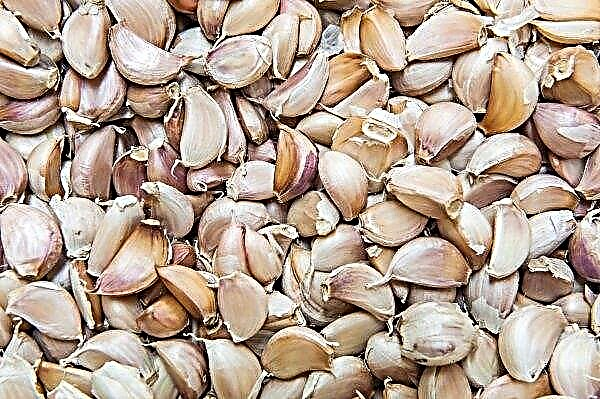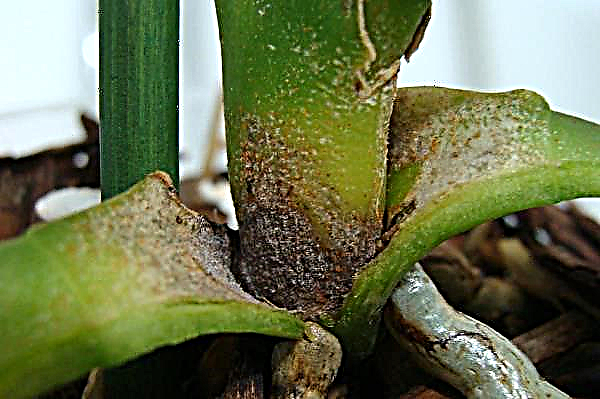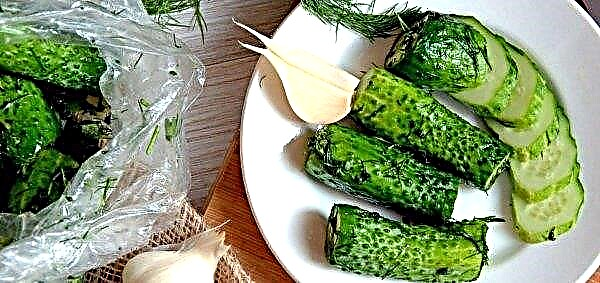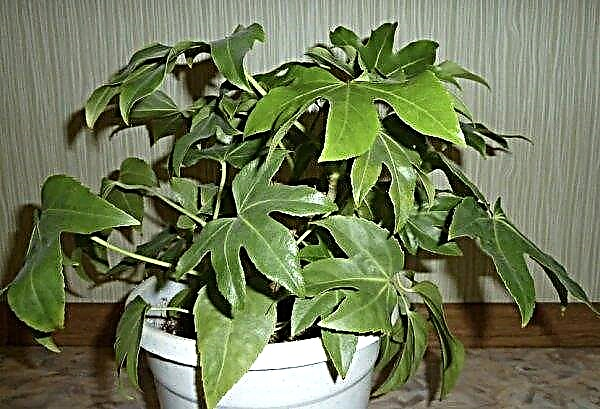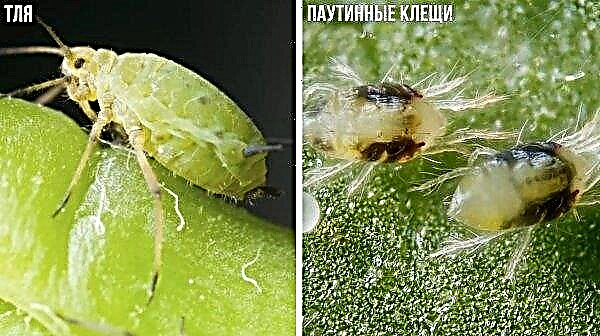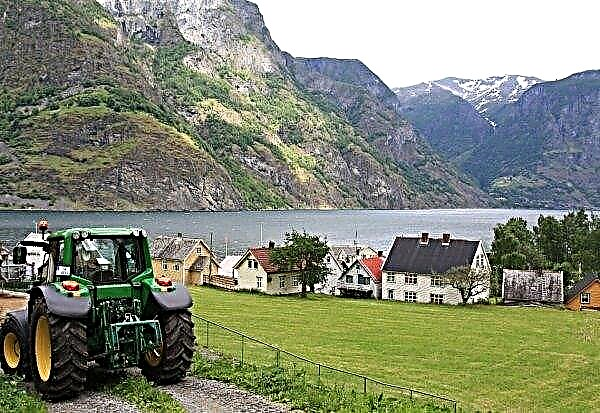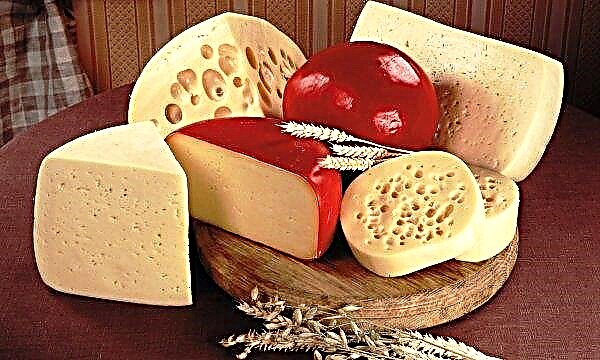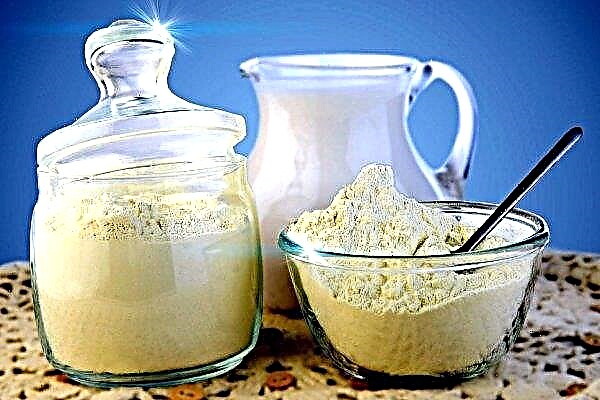Cypress trees are quite popular among gardeners, as they have a wide variety of shapes and colors. They are used as a decorative decoration of the landscape. An example of such a plant is the pea cypress Filifera Aurea Nana, which will be discussed in the article.
Botanical description of the plant
Pea cypress Filifera Aurea Nana is not a real dwarf, but a slowly growing variety, forming a compact oval evergreen crown. This amazing ancient culture is grown both in the form of a tree, and in the form of a bush.
The botanical name in Latin is Chamaecyparis pisifera Filifera Aurea Nana. Another common name is Cypress yellow pea-yellow threadless. Belongs to the genus Cypress (Chamaecyparis). Type - dwarf conifers. Variety - Filifera Aurea Nana.
Did you know? Cypress wood contains essential oils that prevent decay of trees, so they were used in the manufacture of sarcophagi.
Botanical Description:
- The bark is reddish-brown, peeling stripes. The main skeletal branches grow horizontally and droop.
- The needles are scaly, soft, golden yellow or light green, not changing color during the year, the color intensity appears on young shoots and in the sun. Older foliage takes on a dark green hue.
- The shoots are thin, cord-like, dense, branched and curved in an arc (waterfall effect), round in cross section. The annual growth of the crown is 3–6 cm.
- Cones are small (6–10 mm), grayish-green in summer, then turn brown. Appear only on mature plants, grouped at the tips of branches. For the small size of the cones, the variety is also called pea.
- The shape of the crown is weeping, hemispherical (pillow-shaped). Numerous branches provide a dense structure.
- The root system is branched, the roots are thin.
- The height of the plant after 10 years is up to 1 m in height and about 1.2–2 m in the width of the crown.
The variety is frost-resistant and can withstand winter temperatures of -20 ... -30 ° C. This makes it possible to grow it in regions with a cold climate, which is typical for most Russian latitudes. It easily tolerates short droughts, cold, heat.
Name
In the wild, pea cypress grows on the islands of Japan. It is cultivated in many countries of the world. Cypress Filifera Aurea Nana is a dwarf form of the variety Filifera Aurea, bred at the end of the 19th century. in Germany.
Cypress has not only a long scientific name, but also confusing to understand, because it mixed languages and specific terms:
- The name Chamaecyparis means a relative of cypress or undersized cypress.
- Pisifera - the Latin epithet means pea, refers to small cones (false peas).
- Filifera - means "filamentous foliage".
- Aurea (lat.) - gold, gilded silk threads.
- Nana - dwarf, low.
Landing
Planting a cypress should begin with the acquisition of a seedling. It is advisable to do this in special nurseries or professional gardeners who will give appropriate recommendations for planting and care.
You should know the signs of a healthy plant, so as not to make a mistake with the choice:
- branches are flexible and the needles do not crumble;
- there are no signs of disease or pest damage;
- root lump in a holistic state;
- the soil is well spilled and the roots are not dry.
 Thus, three decorative features are noted in the name of the cypress variety - threadlike shoots, slow growth and bright golden needles.
Thus, three decorative features are noted in the name of the cypress variety - threadlike shoots, slow growth and bright golden needles.
Seat selection
When choosing a landing site, it is best to stop on fertile and moderately moist soils, in areas well lit by the sun. Cypress is able to withstand shading, but the color of its needles in full sun takes on a particularly intense color. In the shade, its leaves will simply turn green.
Saplings need a quiet place, protected from winds and drafts. In open space, with frosty winter winds, the plant is easily damaged - it discards the lateral branches, and the needles become brown. The presence of open reservoirs in the neighborhood will give additional humidity, which is favorable for the development of cypress.
 Exhaust fumes and air pollution from chimneys can harm plantings.
Exhaust fumes and air pollution from chimneys can harm plantings.
Soil treatment
When planting to fall asleep, you can use the purchased substrate for conifers or prepare the soil yourself. For this purpose, garden soil is mixed with peat in an approximate ratio of 1: 1 so that it lowers the soil pH to below 6. The reaction can be checked using a soil acid meter. Another version of the soil mixture: leafy soil, coniferous (you can collect it in the forest at the place of growth of spruce and pine) and coarse sand.

Planting a seedling
Young seedlings are planted in early spring or autumn in cool weather, when the plants are at rest. Ephedra planted in spring and summer often dry out and require careful watering. When planting in autumn before winter, plants will take root well and deeply, which is facilitated by autumn humidity and lower temperatures.
When placing seedlings in groups, it is necessary to observe a distance of at least 1 m between the individual specimens, since the root system of the cypress grows, as do the branches in the horizontal direction.

To plant a young seedling correctly and ensure normal development conditions, follow the instructions:
- Dig a landing pit 40–50 cm deep and 60–90 cm wide. It should be large enough (2-3 times the root volume) to freely accommodate the root lump and cover it with soil around. Between the walls of the pit and the root ball, the palm of an adult should fit freely.
- At the bottom, lay a drainage - a layer of broken brick, pebbles, coarse sand.
- Loosen the soil on the walls and bottom of the pit to a depth of 15 cm. This will help the plant grow into the soil and take root deeper.
- Soak the root ball for 15-30 minutes in water to saturate with moisture. Do not violate the integrity of the root coma during planting.
- Pour a mixture of land and peat at the bottom of the pit (10-15 cm), place a root ball in the center, and then fill the space around it. Tamp the soil periodically to ensure better contact of the roots with the soil and remove air pockets.
- Planting depth is extremely important: do not plant the plant too deep or too shallow. The root neck (a fragment of a plant between the roots and the trunk) should be at ground level.
- In case of planting a container seedling, place it at the same depth at which it grew in a pot or 3-5 cm below the surface of the earth, taking into account the subsequent shrinkage of the soil after irrigation. It is worth using a stick that needs to be placed so that it rests on the edges of the hole, thereby determining the appropriate landing height.
- Form a depression around the plant in the form of a wide pool that will hold water and facilitate its flow to the roots.
- Water the landing site well, especially if you plant in the middle of the season when there is little rain.
- Mulch the surface with a bark layer of 5 cm. Such a mulch will prevent moisture loss and will additionally provide the correct level of soil acidity.
Video: cypress landing
Care
Caring for a cypress does not imply any particular difficulties, but at some points you should still stop - it is watering, fertilizing, pest control and shelter for the winter.
Watering and feeding
Watering should be especially taken care of during the first 2 years of growing and during long periods of drought, which is very dangerous for young plants with a weak and shallow root system. As for the irrigation rate, it is better to water once and well than often and economically. Frequent and weak watering leads to the fact that the plants become shallow, because they find moisture in the upper parts of the soil.
 It should be watered abundantly so that the water reaches the deeper layers of the soil - then the cypress rooted deeper. As a result, drought tolerance is generated, and in later years, plants do not need to be watered outside periods of drought, and they can remain longer without water.
It should be watered abundantly so that the water reaches the deeper layers of the soil - then the cypress rooted deeper. As a result, drought tolerance is generated, and in later years, plants do not need to be watered outside periods of drought, and they can remain longer without water.
Adult cypress trees are watered only in dry periods when the topsoil dries to a depth of 20 cm. The culture responds well to sprinkling. But not only in hot weather, but also in spring, plants may not have enough water, especially when they grow on light soil or on rocky ground. In southern regions with little snowy and not freezing winters, cypress can be watered in winter, as photosynthesis of coniferous crops continues in these periods, but only more slowly.
Every year it is necessary to feed the cypress with nutrients 2-3 times in the spring (preferably a universal fertilizer for coniferous crops), and in the fall with special autumn fertilizers. For young plants, mulching with compost is sufficient.Important! Avoid fertilizing on hot days and immediately after planting. To prevent chemical burns of the roots, observe the dilution standards and the uniformity of application of the preparations in the root zone.

Loosening and mulching
Loosening of tree trunks is necessary to saturate the roots with oxygen and ensure air permeability of the soil. This procedure is especially needed after watering in order to avoid the formation of a crust on the soil surface. The depth of cultivation depends on the age of the plant and is 10–20 cm.
Mulching with a layer of 5-10 cm eliminates loosening after watering, retains moisture in the soil, regulates soil temperature and inhibits weed growth. As mulch, peat, straw, wood chips, compost, sawdust, conifer needles, bark of a small fraction, cones - any loose and air-permeable material are suitable.

Pruning
The cypress tree tolerates spring pruning well until new shoots appear. At the same time, broken, poorly formed and damaged by frost branches are removed, the plant is cleaned of dry seed bolls. In hedges, pruning limits the height and size of the bushes.
To create the correct forms (a dense ball or dome), formative pruning of young shoots is carried out, removing only one third of the green mass at a time. In young plants, the central conductor is removed to ensure a rounded shape. Thick branches of old wood should not be shortened, because it weakens and disfigures plants, destroying their unique appearance.Did you know? The oldest known cypress is about 4000 years old. It has its own name (Sarv-e-Abarku) and grows in Iran.

Wintering
Cypress Filifera Aurea Nana loves heat and moisture, so in regions with harsh climatic conditions, it should be covered for the winter. The main factors that can damage the plant are the bright winter sun, cold winds, heavy snow cover and icing.
This can lead to sunburn and “cold” burns, creating unattractive yellow-brown foliage for most of the winter, dehydrating needles, damage to branches and trunk deformation. Winter thaws, followed by frost, can cause cracking of the bark, which worsens the appearance and opens the door for infection.
As a material for shelter suitable:
- lapnik;
- cotton fabric;
- sackcloth;
- agrofibre;
- agrotherm;
- lutrasil;
- spanbond;
- kraft paper.

It is especially important to shelter young plants for the first 3-4 years - they can be covered with wooden crates, and insulated with material from above. Not only the upper part of the plant and needles need protection from the cold, but the root system can suffer from severe frosts when freezing the ground at the base of the tree. To avoid this, the procedure of mulching with a layer of 10-15 cm of trunk circles will help.
Possible diseases and pests
Cypress is resistant to most diseases and is not affected by pests, but under adverse weather conditions, violation of the rules of care, weakened plants become susceptible to fungi that cause root rot. So you should take care of this and monitor the moderate soil moisture and avoid stagnation of water in the zone of the root system.
Hedgerow samples may be affected by gray mold caused by pathogens. If a disease is detected, all infected plants should be sprayed with fungicides twice, every 10-14 days. The rapid growth of the disease is promoted by a high density of plantings and high humidity at a temperature of + 20 ... + 25 ° C, so when watering, it is necessary to avoid wetting of tree branches.
Sanitary pruning of affected areas or the removal of neighboring plantings to ensure air and light permeability will help in the fight against lesions, since in thickened plants without a proper air flow, diseases can spread easily from tree to tree. In extreme cases, the only solution is to remove the whole plant.
To strengthen trees and increase resistance to disease, you need to fertilize them with ammonium nitrate, ammonium sulfate or fertilizer for conifers.
Among pests, aphids, spider mites and scale insects, which feed on plant juices, are especially dangerous. This leads to wilting, yellowing and falling of the needles. For the fight should use special chemicals designed for such lesions.Important! Ephedra require lower fertilizer application rates (about half) than garden crops, so check with your specialists for the dose and frequency of fertilizing.
The use of wood in landscape design
When the landscape has few color shades, and after the autumn leaf fall and in winter everything is gray and mundane, gardeners appreciate plants that give a little color palette to the surroundings.
 Cypress Filifera Aurea Nana is planted as an ornamental plant for landscaping and dividing space, to protect against wind and noise, as ground cover crops. Due to its small size, it can be used for bonsai and for container cultivation to decorate home gardens, terraces and verandas.
Cypress Filifera Aurea Nana is planted as an ornamental plant for landscaping and dividing space, to protect against wind and noise, as ground cover crops. Due to its small size, it can be used for bonsai and for container cultivation to decorate home gardens, terraces and verandas.
Having yellowish shades of needles and a compact shape, the cypress looks good when creating colorful compositions in a rock garden, rock gardens, flower beds, in group and single plantings on a lawn, serves as a real lighthouse in the landscape. These miniatures are in high demand because they take up little space, and the compositions created from them retain proportions for many years.
When forming a landscape design, try to plant conifers away from deciduous trees, as fallen leaves can get stuck in the branches and cause the needles to melt.
Following all the recommendations set forth, you can easily decorate your garden with another representative of coniferous crops - Cypress of Philip Aurea Nana, and add golden yellow threads to the surrounding landscape.

